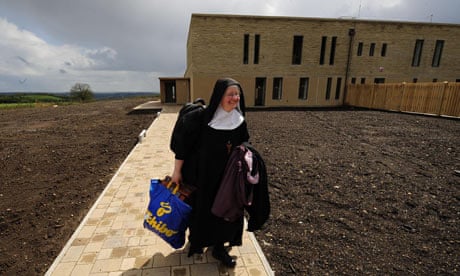It is not often that the Benedictine nuns of the Conventus of Our Lady of Consolation leave their monastery. It is even rarer for them to move monasteries entirely.
But today, the nuns left their Worcestershire home of 171 years to take possession of their new residence in the North York Moors national park – a new building that they insisted must remain as environmentally-friendly as possible as they lead their quiet life of prayer.
Among the £4.7 million building's green features are solar panels to provide hot water, a woodchip boiler that will be fuelled by locally-sourced trees and a roof covered in sedum grass to better insulate the buildings and attract local wildlife.
Rainwater from some of the roofs will be collected and used to flush the toilets and, instead of an electrically-driven waste water treatment plant, the architects have installed a reedbed sewage system. The effluent from the monastery will filter through the reedbed and, after it is processed through natural anaerobic digestion, the resulting water will trickle out onto the surrounding land.
And the basic materials for the building – everything from timber to stone – have been sourced as locally as possible.
"A lot of building projects start out with all these environmental features and, by the value engineering stage, usually you've lost quite a few of them," said project architect Gill Smith of Feilden Clegg Bradley Studios, winners of the 2008 Stirling Prize. "The nuns have been remarkably good at sticking with their principles and not letting them drift as other clients tend to do. The list they've ended up with is quite impressive."
The nuns moved from the Victorian splendour of Stanbrook Abbey in rural Worcestershire because, according to abbess Dame Andrea Savage, manual labour was overtaking monasticism at the site. "We're running a big building, spending thousands of pounds that we don't have on looking after the place and heating it with oil and gas, which isn't good for the environment," she said last year. "We're here for the monastic life and it is being impinged upon."
The new monastery will give its new inhabitants broadband-ready bedrooms for up to 30 nuns, plus a church, library and other ancillary buildings. There is also space for up to 15 guests.
Smith said the project had been a learning process for the nuns and the architects. "For them it was thinking about buildings in the way we think about them, and for us it was getting to grips with the monastic life. The building is their whole world, they're there 24 hours a day all their lives and there's no other building [we have built] that has to meet that challenge. You have to provide everything they could want in life, which is hard. You really want to create a variety of different worlds within it."
